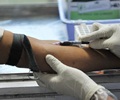Many male clients of female sex workers in Tijuana have unprotected sex
In a study examining HIV infection among male clients of female sex workers in Tijuana, a bi-national team of global health researchers at the University of California, San Diego School of Medicine, has found that over half of male clients had recently had unprotected sex. They also reported a high prevalence of drug use.
"Targeted intervention among male clients is necessary to prevent the spread of HIV and other sexually transmitted infections – intervention that doesn't solely place the onus on female sex workers," said lead author Thomas L. Patterson, of UC San Diego's Department of Psychiatry and the Veterans Administration Health Care System, San Diego.Tijuana, located in Baja California, directly across the border with San Diego, has a thriving sex industry and is a popular destination for U.S. and foreign sex tourists. While the city's health service does license female sex workers, on condition that they are regularly tested for HIV and other sexually transmitted diseases (STIs), only about half of them are indeed licensed. In addition, Baja California has the second highest cumulative AIDS incidence of any Mexican state and, in 2006, the HIV prevalence among female sex workers in Tijuana was six percent. It has been estimated that as many as one in 112 persons aged 15-49 living in Tijuana is HIV-infected.
"Male clients of female sex workers in the San Diego-Tijuana border region act as a bridge that can potentially transmit HIV and other STIs to sex partners, including their wives," said co-author Manual Gallardo, M.D, Patronato Pro-COMUSIDA in Tijuana. "However, given that only 59% of clients reported regularly using condoms with a female sex worker, there appears to be some level of complacency that urgently needs to be addressed."
The study, published in the current on-line issue of the journal AIDS, looked at 400 clients – about half residents of San Diego and the remainder from Tijuana. Their average age was 36.6 years, with the majority Mexican or Hispanic (about 80%) and single, never married or divorced (57.5%). During the past year, clients had sex with an female sex worker an average of more than 25 times and over half of them reported having unprotected sex during the past four months.
While only half of clients reported having been tested for HIV, 14.2% tested positive for at least one STI (Chlamydia, gonorrhea, syphilis or HIV). The prevalence of HIV infection among clients was similar to that of female sex workers in Tijuana. The risk of contracting HIV was highest for those who lived in Mexico, used methamphetamines or had tested positive for syphilis.
"Of those we interviewed, nearly nine out of 10 reported having used illicit drugs during their lifetime," said Patterson. Many were binge drinkers, and one-third said they were frequently high on drugs when with a female sex worker. This profile of substance abuse – especially methamphetamine use – likely contributes to high-risk sexual behavior."
Earlier reports by UCSD researchers suggested that interactions with clients can be a critical barrier to the adaptation of safe sex practices among female sex workers, who reported that some clients are willing to pay double for unprotected sex.
"Our new data suggests an urgent need to develop behavioral interventions to improve the clients' knowledge of the risk of HIV," said co-author Steffanie Strathdee, PhD, associate dean for Global Health Sciences at UC San Diego. "Intensified efforts to 'test and treat' should reach out to this high-risk group in ways that are culturally sensitive, recognizing that some men fail to realize that sexual health is a shared responsibility."
Source-Eurekalert














